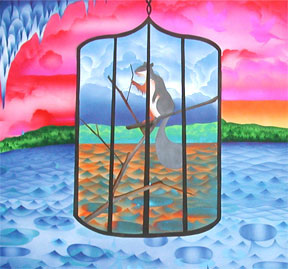
This is a jam packed blog post! I recently finished a couple new pieces, and there are enlargements and details on the website. The image above is Disreputable Miracles, and it's made with markers rather than ballpoint pen, as is the one below, which is called Our Carnal Eyes".

I had occasion to rewrite my artists' statement recently, and it posed an interesting problem for me. I found it difficult to write text about text, and it was particularly weird because several of my new pieces can be read as artists' statements in and of themselves. These last few pieces have been very much about the way I'm thinking about aesthetics and culture. I addressed that aspect of my work when I wrote, and for once my artists' statement doesn't make me cringe when I read it. So if you're interested, here it is, with handy hypertext links to my images because I'm technical like that.
I think of my work as a way of enshrining time spent in doubt. I draw rather than write, and write rather than communicate exclusively through images, because for me the combination is the best way to speak clearly about things I'm not at all clear about. I often make statements that are contradicted by words in the details, or write words in fonts or near images that undermine the meaning of what I'm saying. If I present a self in my work, it's a fractured, contingent self. The sense of breakage is not so much about violence as it is about splitting in the way that a playwright might split himself into several voices or characters to explore an idea. Some of my ideas are best said by cockroaches, or written in bubble letters backwards next to pictures of babies. Words like maybe, possibly and hopefully occur over and over. I'm interested in the contradiction between the amount of time I put in to each piece and the amount of doubt it embodies. I like putting a lot of artistic muscle behind subjective, fluctuating, unresolved ideas.
Several of my recent pieces revolve around questions I have about the relationship between high art and mass culture. Efficacy reads*, "If the value (read: emotional viability) of an image is adversely affected by the frequency of its use, what are we left with?" I come back to this question a lot. I love the art world because it creates a cultural space that values individuality, but I worry that in the process of doing so we've defined ourselves in opposition to mass culture so persistently that it's become easy to dismiss imagery, subject matter and ideas that address universal experiences simply because they are common. I'm interested in pinpointing the time in my artistic development when I realized I shouldn't paint a sunset, or a swan, or anything too girly. (Matthew Barney climbs the levels of the Guggenheim in one of the Cremaster movies- girl art, entertaining and pleasing, is right at the bottom level. He ascends to Robert Smithson.)
I sometimes think that visual pleasure itself has become suspect as subject matter unless it's radically decontextualized, laughed at, or forced into a context that severs its ties to the world around us. I think there's a funny puritan strain in some thinking about art, in which the highest aesthetic experience is the one that is the least embodied. It's as if beauty, because it's been used in advertising, has lost all claims to our attention, except when it can take on a cerebral, nun-like aspect that disavows all connection to the corporeal world, or when it's so debased that it can seem ironic. One of the things I doubt a lot is the idea that using art to entertain, seduce or connect is silly regardless of the context.
I care very much that my work is accessible. One of my students, a working class urban kid, got a summer scholarship to art school. He was impressed with the upper middle class students' drawing ability, but asked with great bitterness, "Why are they so dirty? Don't they ever take a bath?" I tried lamely to explain that they were dirty in a well intentioned attempt to reject their privilege, but I didn't convince anyone. I think about this exchange every time I get asked to talk about my work. It struck me that making work that rejects beauty is the visual art equivalent of not taking a bath. I want my work to look difficult, to be readable, to be pretty and funny and cute and decorative- all the disreputable, supposedly lightweight artistic categories that function to give people who don't know much about art entrance into the work- without sacrificing complexity.
A recent piece, Trade shows a woman figure with text that reads*, "Will (NOT. Hopefully. Maybe.) Trade Beauty for (a secretive and obnoxious system of) Taxonomy." Banners below read, "Our Loves (Eyes) Do Not Betray Us." I'm trying to marry my own primal aesthetic experiences: sunsets, swans, flowers, birds, etc; to primary emotional realities: motherhood, mortality, the natural world, our relationships to ourselves and each other. Trade says, in bubble letters, "The power of that first flower or sunset may fade, but must we throw the ocean out with the bathwater? We seek blossoms as a pure ideation of pink, frightened of pollen and obsessed by bees."
*When I quote my own work I put words that are in small text, or otherwise inserted in a marginal way in to a larger statement in to parentheses.
Also, I just posted images of this piece I did last summer, which is done in ball point pen. It's called Issues.

